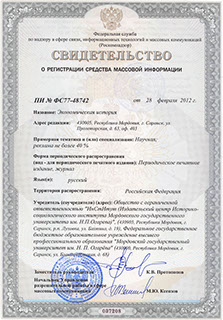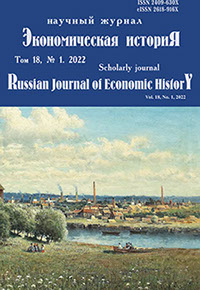Экономическая историЯ
Russian Journal of Economic History
ISSN 2409-630X (Print)
ISSN 2618-916X (Online)
Expert board:
- Scientific Council of RAS on economic history;
- Research and Educational Center «The economic history of Central Russia and the Middle Volga region» of Ogarev Mordovia State University;
- Center of Economic History of Lomonosov Moscow State University
Navigation
Certificate of registration

ISSN 2409-630X (Print), ISSN 2618-916X (Online)
DOI: 10.15507/2409-630X.056.018.202201.018-025
УДК 336.23(470)’’18/19”
Pavel N. Aleshin
Bashkir State University (Sterlitamak, Russia),
e-mail: p.n.aleshin@gmail.com
Assessment of the Formation of Zemstvo Budgets in Russia at the End of the 19th– Early 20th Centuries in the Works of Contemporaries
Introduction. The idea of introducing zemstvo self-government in the Russian Empire from the very beginning divided the population into bright supporters and ardent opponents, who for decades proved their case. The process of creating zemstvos began in 1864. The state determined socially significant functions for these self-government bodies: the development of medicine, education, agronomy, veterinary medicine, road construction, etc. The problems faced by the zemstvos were big: relationships with power structures, budget deficits, and the attitude of society. You can get acquainted with the activities of the zemstvos, the difficulties in the work by studying the journals of the meetings of the zemstvo assemblies. Also, of interest is the opinion of contemporaries about these self-government bodies. The purpose of the article is to consider the mechanism of formation of zemstvo budgets through the analysis of the works of contemporaries. Materials and Methods. The set goals were solved using narrative (description of the history of the issue), historical and genetic (development of zemstvo self-government and changes in the principles of taxation), comparative (positions of A. A. Golovachev and V. N. Tverdokhlebov), systemic (analysis of the consequences of changes in local self-government) methods. Results. For more than half a century of activity of zemstvo self-government bodies, the problems have not changed much. Both in the initial and in the final period there were great difficulties with the formation of the budget and the designation of taxable items. Discussion and Conclusion. Land remained the main taxation item, which led to an increase in the deficit due to the overtaxation of landed property, the poverty of the main taxpayers – the peasants; a low level of taxation was observed for urban real estate, commercial and industrial enterprises, which was supported by the government.
Keywords: history of Russia, zemstvo self-government, budget, income items, estimate, property.
For citation: Aleshin P. N. Assessment of the Formation of Zemstvo Budgets in Russia at the End of the 19th – Early 20th Centuries in the Works of Contemporaries. Ekonomicheskaya istoriya = Russian Journal of Economic History. 2022; 18(1): 18–25. (In Russ.). DOI: 10.15507/2409-630X.056.018.202201.018-025.
© Ogarev Mordovia State University. History and Sociology Institute, 2017
68, Of. 411, Bolshevistskaya St., 430005, The editorial office of the scholarly journal «Russian Journal of Economic History»
Tel.: (8342) 24-25-90; 27-07-11, Fax: (8342) 24-25-90, E-mail: jurnal-econom-hist@isi.mrsu.ru
Designed by A. Napalkov, Email: napalkov@isi.mrsu.ru

